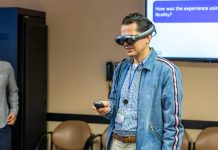Peripheral awareness is critical in everyday life whether we are driving a car, playing a team sport, or walking in a crowd. It enables us to stay focused on what is in front of us while seeing actions or objects positioned alongside us. With peripheral vision, we can avoid traffic accidents, anticipate the moves of our teammates or opponents, and not bump into people.
If you concentrate on looking intently at one object in a room, after a while the rest of the room starts to blur and disappear; you have achieved “hard focus.” Hard focus can be useful, but is limiting. In Asian martial arts such as Aikido or Tai Chi, they talk of “soft eyes,” “soft focus,” or “wide-angle seeing.” The Samurai warriors are said to have cultivated a 360-degree field of awareness to deal with attacks from all sides.
In the world of cyber, soft eyes has another name: “ambient awareness.” According to user experience designer Leisa Reichelt, ambient awareness “is about being able to keep in touch with people with a level of regularity and intimacy that you wouldn’t usually have access to, because time and space conspire to make it impossible.”
We can experience ambient awareness when using social media tools such as Facebook or Twitter. Each individual update that comes our way might be relatively insignificant, but over time these fragments of information gel into meaningful patterns, i.e., they provide us with digital peripheral vision of people, actions, and events.
Why is this important?
The success rate of projects is not particularly impressive. According to a 2013 Standish Group study, only 39 percent of projects were successful (delivered on time, on budget, and with the required quality). Another 43 percent were considered to be “challenged” (late, over-budget, and/or with low quality). The failure rate was 18 percent (cancelled or not used). Are things getting better? Not according to the Project Management Institute. In its 2016 Pulse of the Profession Survey: “Compared to last year, fewer projects are being completed within budget or meeting original goals and business intent. More projects are actually failing and creating significant monetary loss for their organizations.”
The project ecosystem is complex and dynamic. The continuous drive for innovation in the hyper-competitive and hyper-volatile environment means that project leaders rarely—if ever—enjoy a tolerable sense of control over projects (you are building the boat and rowing it at the same time). Teams are often unstable configurations of people who don’t know each other—being as they are distributed across multiple geographic and cultural borders. In the turbulent global environment, teams also face great ambiguity and fluid project requirements. Add virtuality to the mix, and misinformation and miscommunication run riot in the project playground.
To increase virtual project performance, we need to bring together traditional project management tools with the ambient awareness, transparency, fluid information sharing, and self-organizational capabilities of social media.
Traditional project management emphasized the role of the controlling project leader. Project leadership will not disappear in a social project management space, but it will be enriched by engaged project team members who have:
- Greater peripheral vision regarding the project (big picture) and project team members
- Open and continuous communication (through activity streams) available on all devices
- More cohesion and trust
- Greater spontaneity in creating and sharing project updates
- Increased project participation and alignment
- Faster identification of learning and other resources
- Increased access to real-time project data and user-generated content (including best practices)
- Emergent—rather than overly centralized—planning and control (providing greater agility in a volatile environment)
The social side of virtual collaboration adds the interpersonal “being present” and “working out loud” dimensions that easily get lost in the digital workplace: Who are my colleagues? Who is around? What do they know? What are they doing now? What are they thinking and feeling? What do they want from me? How are things going? What challenges are they facing and how are they overcoming them?
If you are a virtual project leader, what can you do to increase your team’s peripheral vision?
Think Forward: Clarify your goals for using social media in your virtual projects, develop a strategy for implementation, identify appropriate tools for meeting your goals within your business, and define rules of engagement/policies for use. Identify any training that might be required for sustainable success.
Think Laterally: You don’t have to be alone in Thinking Forward (in fact, you shouldn’t be). Talk to past members of your virtual project teams—how could social media have helped them be more efficient and effective, and what have they learned since working with you (from their personal and professional use of social)? Set up or join a community of interest focused on social media in virtual collaboration. Tap into your business networks to see what other companies have been doing, especially what challenges they have faced, e.g., any HR issues or over-policing problems. Identify how they overcame their challenges.
Think Vertically: How will you persuade others (especially decision-makers and budget holders among senior managers) of the wisdom of your ideas? What is your value proposition? What is the likely return on investment (if any investment is actually required)? How will you identify and leverage the intangible benefits? How will you protect proprietary data and intellectual property, as well as the company’s reputation?
When we worked in the same spaces and on the same projects, it was relatively easy to see through both our “hard” and “soft” eyes. Our colleagues were right there with us, and so we shared the same information and could see and hear what was happening and being thought. Collaborating virtually fragments our project experience, and so we must train ourselves to strengthen our “soft” eyes; how else will we see the threats and opportunities lying in the virtual periphery?
Terence Brake is the director of Learning & Innovation, TMA World (http://www.tmaworld.com/training-solutions/), which provides blended learning solutions for developing talent with borderless working capabilities. Brake specializes in the globalization process and organizational design, cross-cultural management, global leadership, transnational teamwork, and the borderless workplace. He has designed, developed, and delivered training programmes for numerous Fortune 500 clients in the United States, Europe, and Asia. Brake is the author of six books on international management, including “Where in the World Is My Team?” (Wiley, 2009) and e-book “The Borderless Workplace.”




